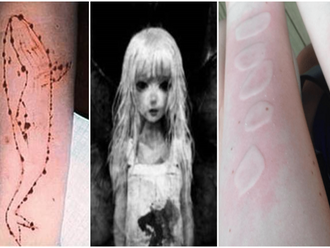
There are few illnesses as terrifying in the public consciousness as cancer. With up to a third of us getting cancer at some stage in our lives, it is almost impossible to go through life untouched by the disease. As an ominous reminder of our mortality, cancer scares us to the point that discussions about it are often avoided and the language we use is couched in euphemisms.
The recent Channel 4 documentary “You’re killing my son” told the story of Neon Roberts, a young boy whose treatment for a brain tumour was halted by his mother Sally, who remained convinced that radiotherapy would cause long-term harm and wanted to try alternative medical treatments.
After a difficult court battle, Neon received radiotherapy, leaving his mother somewhat unimpressed. “Death by doctor is very common, but thankfully, because of the internet these days a number of us have educated ourselves,” she says in the documentary. “There’s so many other options that we’ve been deprived of, denied.”
The Neon Roberts case is tragic, but it reveals the quagmire of misinformation that surrounds the disease — half-truths and wishful thinking about cancer abound. But Ms Roberts’s comment should not be dismissed on a whim. Misguided though she might be, her point that the internet is full of information on cancer cannot be denied. Much of it is dubious and outlandish, but differentiating between fact and fiction can be difficult and a host of myths about cancer have found new life online.
While it would be impossible to address all the legends on the subject, it is worth dispelling some of the more persistent misunderstandings.
Cancer rates are rising
This statement is true in one respect and it is often framed as “proof-positive” that our world is becoming more carcinogenic. Age is the single biggest risk factor associated with developing cancer and as we are living longer it is hardly surprising that rates are increasing. This merely means we are now less likely to die of the host of plagues and injuries that ravaged generations before us. What is heartening is that survival rates have also improved substantially due to more effective diagnostic techniques and treatments.
Sharks don’t get cancer
“Sharks don’t get cancer!” is a factoid that has burnt its way into the public consciousness to such an extent that nothing short of a cultural lobotomy can erase it. The perceived immunity of this predator to cancer has led to its slaughter in order to harvest its allegedly curative cartilage; not only is this no good for sharks, it is no good for humans either.
Sharks do get cancer — indeed, pretty much all complex multicellular organisms do, from dogs to elephants.
The myth that “sharks don’t get cancer” was popularised in a 1992 book of the same name by Dr William Lane. It is estimated that North American shark populations have shrunk by 80 per cent in the past decade, with over 200,000 sharks harvested every month to create a pill that doesn’t work. It will perhaps come as no surprise to the cynical reader that Dr Lane has built business interests in shark fishing and cartilage pills.
Cancer is a modern disease
Egyptian doctors were recording cancers of the breast sometime between 1,500 and 3,000BC. By 400BC, the Greek physician Hippocrates (he of the oath) had distinguished between benign and malignant tumours. Incidentally, the early Greek scientists of this period called it cancer because they thought clusters of tumours looked like crab legs. If this seems a slightly odd simile, bear in mind Greek medics were not familiar with dissection and so could only observe protruding tumours. The reality is that cancer is a truly ancient disease and has likely existed since the dawn of humanity and before it in the primate species from which we are descended.
Radiotherapy and chemotherapy are poisons
In a manner of speaking, yes — that is the idea. Both radiotherapy and chemotherapy damage DNA. Tumour cells are mutants and while they proliferate far more than they ought, they are much more susceptible to damage and much less likely to be repaired successfully than surrounding healthy tissue. As a consequence, a well-planned radiotherapy dose is concentrated on areas where tumours have been located, preferentially killing tumour cells and largely sparing healthy tissue and organs.
Chemotherapy targets cells that divide rapidly, such as cancer cells. This can also affect non-tumour cells that divide rapidly, such as bone marrow and hair follicles.
The aim of both therapies is to kill off tumour cells while ideally sparing non-tumour cells and this is why they are effective and why they have side-effects. The “poison” mantra is often a banner hoisted by those championing some alleged alternative treatment with no side effects, conveniently ignoring the fact that a cancer treatment without side effects is unlikely to be killing any cancer cells.
There is a cure, but big pharma is suppressing it
The assertion that there is a “suppressed” cure for cancer is a depressingly common one. A number of documentaries purport to investigate alternative cancer cures, from healing oils to homeopathy, all allegedly suppressed by the “cancer industry” to protect its cash cow.
Cancer is caused by the unregulated division of mutant cells, which can invade adjacent tissue or travel through the body in a process called metastasis. Because cancer can arise from practically any type of cell mutation, there is a huge range of malignancies — some respond well to surgery, others to radiotherapy, and others to chemotherapy. Some tumours are too advanced to cure, but can be treated palliatively with such interventions.
The prognosis and survival rates for different cancers vary hugely — slow growing, promptly diagnosed and easily accessed tumours tend to have a good prognosis. Non-melanoma skin cancer and breast cancers, for example, tend to have relatively good prognoses. Other tumours grow rapidly or present with clinical symptoms only when quite advanced, rendering them harder to treat.
To add to this complexity, one must also consider that each cancer is unique to that patient because it arises from mutations in their own cells. Consequently, the idea of a single magic bullet to treat all these forms with different causes, pathologies and responses is extremely far-fetched and should be treated with scepticism.
So too should conspiracy claims, such as this gem from the infamous bastion of misinformation Natural News:
“ ... the cancer industry world-wide is estimated at a 200 billion dollar a year industry. There are many in various associated positions within that industry who would be without a job if that cash flow dried up suddenly with the news that there are cheaper, less harmful, and more efficacious remedies available. Big Pharmacy would virtually vanish.”
This charge fails even a courtesy examination. If big pharma did possess a cure for cancer, then surely their senior executives and researchers would never die of the disease? And a secret like that is not possible to contain for long, no matter how unethical the companies involved.
But the final nail in the outlandish coffin of this argument is the flashing-light-adorned-elephant dancing in the centre of the room: if there were an effective cure for cancer, why on earth would a pharmaceutical company NOT sell it?
Cancer can be cured by X
The spectrum of alleged cancer cures is alarmingly wide, but typically the product is “natural” and easily acquired — for example, apricot seeds, graviola, mistletoe and even baking soda have been championed as cancer cures despite little or no clinical evidence.
Exotic combinations of everything from herbs to vitamins are sold and marketed as potential cures, but there is simply no evidence that they work. The FDA keeps a list of known fake cancer treatments in an attempt to combat such misinformation.
Others claim that magnets can cure cancer, but the research into “magnetic therapy” shows that such static fields are biologically inert and this is wishful thinking.
While these people may be well-meaning but misinformed, there are more dubious outfits such as the Burzynski clinic, which claims to have pioneered a new form of cancer treatment known as antineoplastons. Yet since its foundation in 1976, the clinic has produced no peer-reviewed evidence that its wares actually work, and charges patients colossal amounts of money to undergo clinical trials, an ethically questionable practice. Critics of the clinic have been subjected to threats of litigation.
Stanislaw Burzynski, its founder, has been sued by ex-patients for defrauding them. Despite this, he is often framed as a hero being suppressed by “big pharma”, tying neatly into the conspiracy fallacy and ignoring the fact that such organisations make substantial profit from very ill people without offering any verified treatment.
To quote the late, great Patrick Swayze, who died of pancreatic cancer in 2009: “If anybody had that cure out there like so many people swear to me they do, you’d be two things: you’d be very rich, and you’d be very famous. Otherwise, shut up.”
Cancer is scary, but it should not be forgotten that treatment options and outcomes have never been better and continue to improve. As the Neon Roberts case demonstrates aptly, misinformation can cause serious and potentially tragic problems. It is natural for people to have concerns and questions, and a talk with one’s physician, nurse or healthcare adviser can do much to answer questions and assuage fears.
While the internet is a potentially fantastic source for information (Cancer Research UK has some very useful patient resources), great care must be taken to avoid treating spurious information as factual. Carl Sagan’s famous dictum that, “Extraordinary claims require extraordinary evidence”, should always be kept in mind when dealing with promises of miracle cures.
—Guardian News & Media Ltd
David Robert Grimes is a physicist and researcher at Oxford University.











